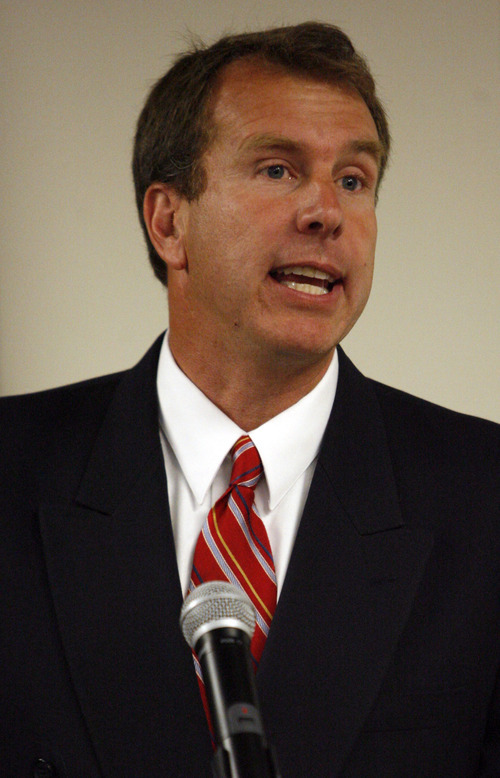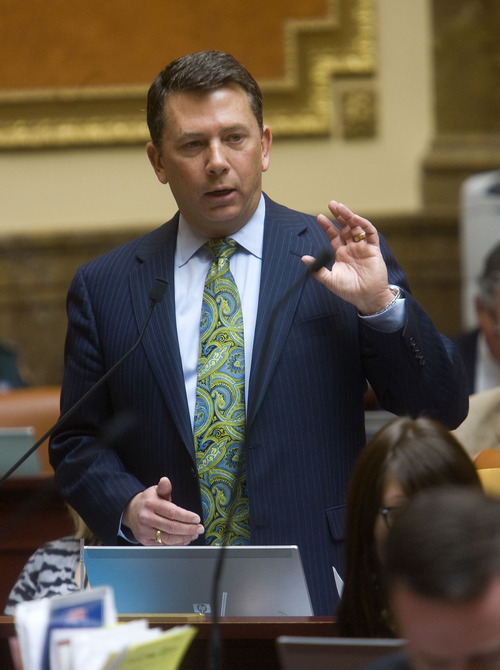This is an archived article that was published on sltrib.com in 2011, and information in the article may be outdated. It is provided only for personal research purposes and may not be reprinted.
The Legislature's Redistricting Committee stumbled Wednesday in an attempt to finish new Utah Senate districts when several members and community groups complained that a draft proposal was unfair to their home areas, and the group voted abruptly to adjourn.
"It's back to the drawing board for now," Sen. Ralph Okerlund, R-Monroe, the Senate chairman of the committee, said afterward. "But time is becoming an issue. We only have a month to finish these maps" for the Legislature and Congress.
A special session of the Legislature is scheduled for Oct. 3.
Okerlund had worked with the group's senators to draft a map that would shrink the state's seven Democratic districts — all in Salt Lake County — into six, eliminating one. Except for Democrats, committee members seemed fine with that. But several had heartburn with how the map would divide their own communities.
For example, Senate President Michael Waddoups, R-Taylorsville — who made the motion to adjourn — complained that Okerlund's map made Utah County "the center of the universe" by giving it the district taken away from slower-growth areas represented by Salt Lake County Democrats.
Waddoups said western Salt Lake County — where his district is based — has roughly the same population as Utah County but was not being given the same consideration.
He complained that his hometown of Taylorsville was divided into three pieces by the map.
He said because he is not planning to seek re-election, it may make sense to divide Taylorsville more than other areas to provide population to solve problems and possibly help incumbents elsewhere — but it should not be sliced that much.
Rep. Francis Gibson, R-Mapleton, did not like how the map would halve Springville and put it, Mapleton and some other Utah County areas into a rural Senate district that stretches south all the way to the distant Arizona line.
Numerous Tooele County officials and residents protested how the plan would divide their county. For example, Tooele and distant Brigham City would be in a district connected on the map only through the Great Salt Lake. Rep. Doug Sagers, R-Tooele, complained, "There is no road through the Great Salt Lake to Brigham City."
He and other Tooele officials alleged that was done to protect Sen. Peter Knudson, R-Brigham City, by taking just enough population from Tooele County to allow him not to be combined with other northern Utah lawmakers.
Some good-government groups also griped that the map may aim more to protect incumbents than keep communities of interest together — and they voiced that complaint after the committee took some overt steps to protect incumbents.
For example, Okerlund explained his map made numerous changes to avoid a proposal to put Sens. Luz Robles, D-Salt Lake City, and Dan Liljenquist, R-Bountiful, into the same district. He also had told the media that his map had avoided putting any incumbents together in districts except in the combined Democratic areas — where he has said Democrats would be allowed to draw their own boundaries.
Also to protect incumbents, the committee voted Wednesday to tweak an already-adopted state school board map.
It made amendments that moved Chairwoman Debra Roberts and member Craig Coleman out of the same redrawn district, and also moved members Michael Jensen and Joel Coleman out of another redrawn district.
Amid such steps, Sarge Froehle, of Represent Me Utah!, told the committee, "The people want to be heard, not herded. That appears not to be happening. … Why are we protecting incumbents? Why aren't you listening to what we say?"
The committee has yet to draw maps for the Utah House and Congress. Waddoups said Okerlund's Senate map seems to be moving in the right direction but needs more work before a final vote.
Sandstrom vs. Herrod?
A duo that fights shoulder to shoulder against illegal immigration — Reps. Stephen Sandstrom, R-Orem, and Chris Herrod, R-Provo — may be fighting each other for re-election next year.
Rep. Ken Sumsion, House chairman of the Redistricting Committee, said Wednesday his latest redistricting plan pits that pair against each other, and it is backed by most Utah County lawmakers. He said growth was slow in Provo and Orem in the past decade, so a district must be moved from there to fast-growing northern Utah County.
"It's not an absolutely done deal, but it is significantly far down the road," Sumsion said.
Is the pair being punished for not backing a package of immigration-reform bills that passed this year?
"I voted against it, too, and this is my [redistricting] proposal," said Sumsion, R-American Fork. "This is hard because Representative Herrod is one of my best friends, and we have worked together in the Patrick Henry Caucus."
Sumsion said the proposal once appeared easier when Rep. Jason Chaffetz, R-Utah, was talking of running for the U.S. Senate, and Sandstrom talked of running to replace Chaffetz in Congress. But Chaffetz decided to seek re-election.





